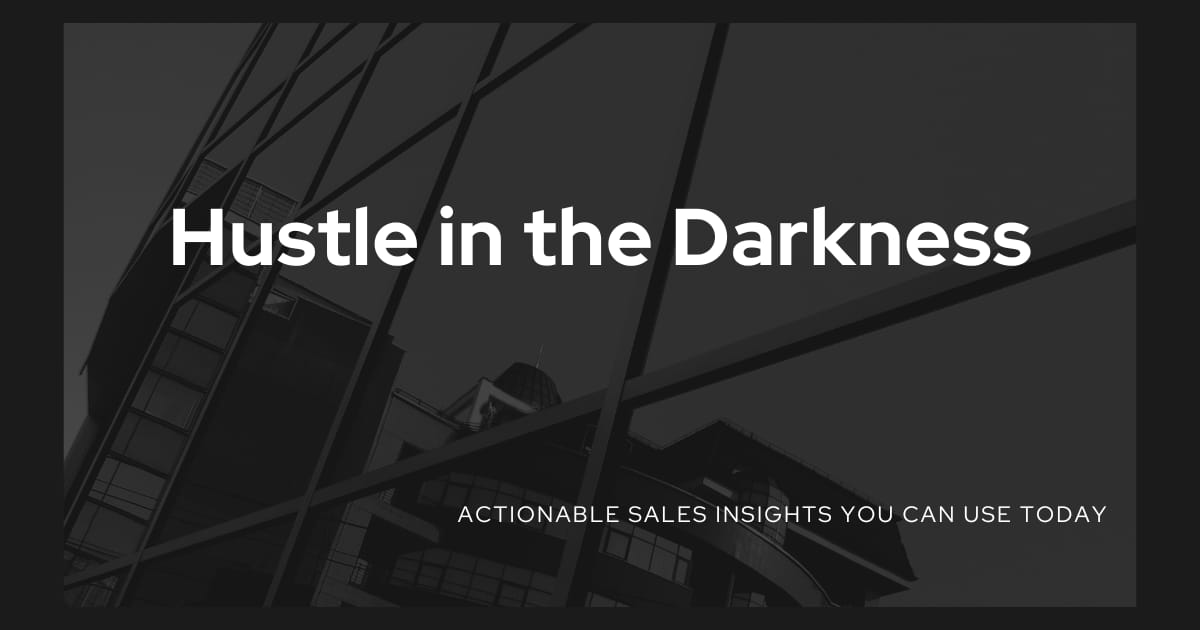Read on: My website
Read time: 2 Minutes
Let’s get real: the easiest way to lose in business is..
to wait for “the perfect moment.”
While you second-guess that $50K investment, your competitor spends it, upgrades ahead, and wins the $1M deal you were banking on.
While you debate a minor marketing spend or put off compliance for one more quarter, they move, they grow, and you get left behind.
Everyone loves to talk about ROI, but no one wants to look at the cost of doing nothing.
The reality?
You pay for inaction in lost deals, lost relevance, and lost momentum. Every strategic delay is just an invitation for a faster competitor to eat your lunch.
Selective hesitation can really cost you business, because the scariest number isn’t what you spend, it’s what you’re silently losing every day you wait.
Was this newsletter forwarded to you?
Here's the brutal truth I learned: The most expensive mistake in business isn't spending money on the wrong thing, it's refusing to spend money on the right thing until it's too late.
This week, we're diving deep into the Cost of Inaction, the hidden killer that's sabotaging your biggest opportunities and company growth while you sleep. Because when you lose your next deal to a competitor who moved faster, you'll have no one to blame but yourself.
Ready to stop being your own worst enemy?
Let’s dance.
The back office, built for founders
We’ve worked with over 800 startups—from first-time founders at pre-seed to fast-moving teams raising Series A and beyond—and we’d love to help you navigate whatever’s next.
Here’s how we’re willing to help you:
Incorporating a new startup? We’ll take care of it—no legal fees, no delays.
Spending at scale? You’ll earn 3% cash back on every dollar spent with our cards.
Transferring $250K+? We’ll add $2,000 directly to your account.
Most businesses obsess over ROI—Return on Investment. They calculate every dollar spent against every dollar earned. But there's another metric that deserves equal attention: COI—Cost of Inaction.
The numbers are staggering:
88% of Fortune 500 companies from 1955 are no longer on the list—many failed not because they made bad decisions, but because they delayed making necessary ones
Companies experience $43 million in losses annually due to poor technology adoption and underutilization
Penalties for noncompliance for CMMC far exceed the investment, ranging from $5k - $150k!
Technical debt from delayed decisions increases project costs by 20-30%
Translation: While you're calculating whether you can afford to invest, your competitors are calculating how much market share they can capture while you hesitate.
Check out some of my past newsletters that focus on how you can develop growth here:
1. Opportunity Revenue Loss
The reality: Every day you don't have the capability your competitors do is revenue walking out the door.
Example: A cybersecurity firm delayed investing in AI-driven threat detection for one year. During that time:
Average data breach cost: $4.88 million
AI-powered security savings: $2.2 million per breach
Market share lost to AI-enabled competitors: 15%
The math: The $100K AI investment they delayed cost them $3.2M in prevented breaches and lost competitive positioning.
2. Marketing & Business Development: Speaking at Conferences, Building Market Trust
Lost Visibility
If your company skips key industry events or just relies on attending events, competitors become the go-to experts and panel spots that should have been yours.
Forgoing conference sponsorship or speaking means you lose out on dozens of “warm” buyer introductions that turn into pipeline.
Result: Your sales and marketing team spends more on cold outreach but closes fewer deals.
2. Delayed Reputation Growth
Declining to invest in market-facing thought leadership slows the trust curve.
Result: It takes years longer for prospects to see you as a credible, low-risk choice.
3. Higher Customer Acquisition Costs
When you aren’t at the table, your marketing must spend more on paid channels to get the same attention organic presence brings at industry events.
Result: Lower ROI on campaigns and a steeper climb to hit growth targets.
4. Reduced Referral and Partner Opportunities
Not showing up to connect in person means missing out on indirect deal flow from peers, partners, and influencers who would otherwise send business your way.
Result: You miss “bonus” revenue that comes from being trusted and visible where it counts.
3. Cybersecurity Maturity Model Certification (CMMC)
Immediate Disqualification From Federal Contracts
Starting November 10, 2025, if you’re not CMMC 2.0 certified at the required tier, you will not be eligible for new Pentagon contracts. The DFARS amendment is explicit: no certification, no award, no exceptions.
Result: Your entire defense pipeline is shut off overnight. There is no “catch up later”; you’re out until you prove compliance.
2. Lost Revenue From Existing Customers
Major primes and federal customers will rapidly drop non-compliant vendors. They can’t afford supply chain risk post-DFARS. If you don’t meet at least Level 1 or Level 2 (self–assessment, C3PAO, or depending on data sensitivity), you’ll watch your contracts churn to competitors.
Result: Not only do you miss new work, you leak recurring revenue and lose the core of your public sector business.
3. Increased Breach and Liability Risk
Skipping CMMC standards makes you a soft target. With every adversary targeting the Defense supply chain data, being behind means you’re the low-hanging fruit and liable for damages and regulatory action in the event of a breach.
4. Higher Costs and Chaos to “Catch Up”
If you wait until compliance is urgent, you’ll be forced into last-minute consulting, audits, and workforce retraining. Temporary “POA&M” (Plans of Action and Milestones) conditional certifications give you only 180 days, mostly at Level 2 or 3, to fix gaps—a tight, disruptive window.
Result: You’ll pay 2–5× what proactive firms spend, burn out staff, and disrupt operations.
4. Cost of Policy Inaction
Your Competitors Write the Rules
Miss a session or delay weighing in, and rival lobbyists fill the vacuum; they shape regulations to favor themselves and freeze you out.Late Entry = Lost Leverage
Coming in after the bill drops means your influence is gone. By then, decisions are baked, and you're stuck fighting uphill.Missed Alliances
Hesitation costs you relationships with key legislators, staffers, and coalitions, assets that can’t be built overnight in a crisis.Reaction, Not Strategy
When you wait, you spend precious capital cleaning up problems, not setting the agenda. What position do you really want to be in?Permanent Reputation Penalty
Policy makers and lobbyists remember who shows up and who doesn’t. Inaction brands you as a bystander, not a stakeholder, impacting every future conversation.
The Accountability Mirror: Why You Can't Blame Anyone Else
Here's the uncomfortable truth about the Cost of Inaction: When you lose deals because you delayed necessary investments, you can't blame market conditions, bad luck, or unfair competition. You can only blame yourself.
Every competitor who invested while you waited is now positioned to win opportunities that could have been yours. Every capability gap that exists because you delayed action is a self-inflicted wound. Every deal lost to better-prepared competitors is the direct result of your choice to calculate instead of commit.
The market doesn't care about your decision-making process. Customers don't wait for you to get ready. Your competitors certainly aren't pausing their progress while you weigh options.
When the next big opportunity slips away because you lack a capability your competitor invested in months ago, remember this: That loss is on you.
Not your budget constraints. Not your cautious CFO. Not your risk-averse board. You had the same information they did, the same market pressures they faced, and the same opportunities to act. They moved. You didn't.
Your Next Move: The Inaction Audit
This week, conduct your personal and team inaction audit. List every investment, upgrade, or strategic move you've been considering for more than the past year.
Calculate the monthly cost of not having that capability, lost productivity, missed opportunities, and competitive disadvantages.
Multiply by the months you've already delayed. Compare to the actual investment cost.
This week, audit your delayed decisions:
List every investment or upgrade you've been "considering" and prioritize them
Calculate the monthly cost of not having that capability
Multiply by the months you've already delayed
Compare to the actual investment cost
Prioritize based on COI-to-investment ratios
Add in how many opportunities/deals will be impacted due to inaction, and for how long?
What happens if you…don’t do anything?
What the Internet Taught Me This Week
From new tools, recent trends, and market updates, here is what has been on my mind.
Free users rejoice! Spotify will now let free users pick and play tracks. Check it out here
College Gras hit the hardest with joblessness. Check it out here
North Korean Hackers Deploy Deepfake Military IDs in Spear-Phishing Campaign. Check it out here
Every time you delay an investment in visibility or compliance, you’re not just saving money; you’re silently paying the price in lost deals, missed relationships, and declining relevance.
Show up late or not prepared for your market, and you compete from behind. Ignore compliance requirements, and you disappear from the shortlist before the game even starts.
If you want opportunity, loyalty, and growth, you have to earn them in advance.
The cost of doing nothing is real, and its bill always comes due. When it does, the only person you can blame is the one staring back at you in the mirror.
Let’s kick into action. See you next week.
Whenever You're Ready, Here are 4 Ways I Can Help You:
Unlocking Hidden Potential - Reconnecting with Past Clients for Explosive Growth - Check out my free eBook on how you can find hidden gems in your past clients and help you crush your sales goals.
Build your Sales CRM - Download our free Sales eBook on How Your Sales Team Can Maximize Your CRM Tool. Whether it’s Hubspot, Salesforce, or another CRM tool, make sure you leverage it to your advantage.
Awesome Sales Resources - Transform your sales engagement and capabilities across Social Selling, CRM, Lead Generation, Enablement, and more.
Cribworks Advisor Program - Want more than just resources? Reach out to me and see if our Advisor Program can help you grow your business.



